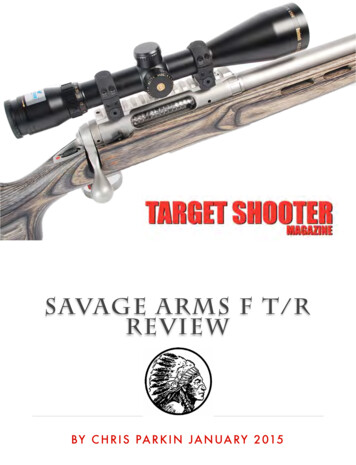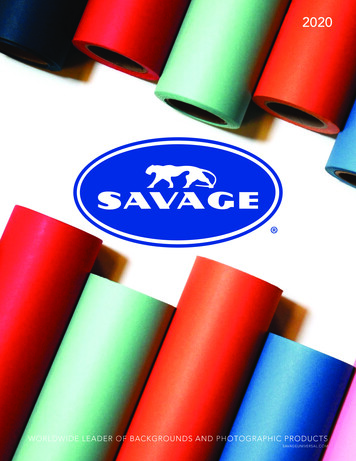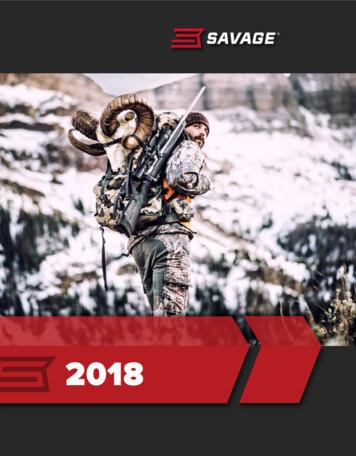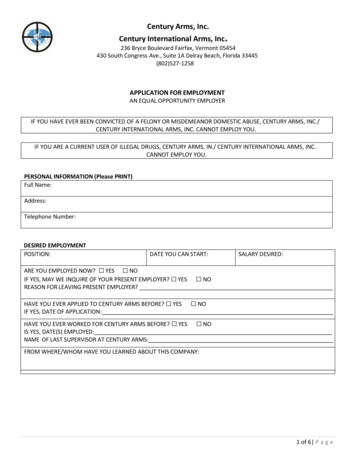
Transcription
SAVAGE ARMS F T/RREVIEWBY C H R I S PA R K I N JA N UA RY 2 015
SAVAGE ARMS FTRBY CHRIS PARKINI have wanted to get my hands onone of these rifles for ages. This gun isthe epitome of what Savage seems to doso well - observe the developing riflemarkets and produce guns thatspecifically fit evolving disciplines andcompetitive rulebooks. The Model 12FTR is Savage’s suggested route fordirect factory rifle ownership to suit therapidly growing world-wide F Classdiscipline. Available in the two FTRcartridges - a 223 Rem with a 1 in 7 twistrate and here, the 308 Winchester with a1 in 12 twist. It had my name written allover it when it came for test - despite thefact that I’m not a regular F Classcompetitor.Little or large?What differentiates a capable FTR riflefrom any other 223 or 308 ispredominantly barrel-length. To achievereliable supersonic flight all the way to1000 yards, possibly even 1200 yards,inches matter. Although the twist-rateof the 308 on test is pretty standard forthe caliber at 1 in 12, the 1 in 7 twist onthe 223 is there to stabilise bullets in the80-90 grain category - capable ofholding their ownagainst the308 whenlauncheda tsimilarvelocities.The heavy 30 inch barrelhas a straight taper from 1.25inches at the breech to 0.940 in. indiameter at the muzzle, which is finishedwith a sharp 90 degree recessed crown.1
The stainless-steel isfinished, like all themetalwork, with a satinbead-blast.The actionand barrel are attachedtogether with the familiarcannelured Savage barrel-nut,with twin gas-escape portsbroadside the bolt-recess. Thebarrel-nut system is there tospeed-up assembly/headspace butit’s a useful feature, allowing almostDIY barrel-changes.I really like Accutriggers, especially whenconsidered they basically feel to function like atwo stage unit.A conventional but stout recoil-lug issandwiched between the action andbarrel but the bolt assembly is somewhatless than conventional in that theseparate two-lug bolt-head is pinned tothe bolt-body. There is a conventionalplunger-ejector and sliding extractorclaw inlet into the right lug face. Behindthis, we see Savage’s characteristicsecondary lug pairing, also floating topromote bolt-face alignment and, shoulda calibre change ever be desired, easilyreplaced if bolt-face alternatives arerequired.The bolt itself is a stainless shaft, engineturned for slick appearance andhandling with the separate ‘tear-drop’bolt-handle retained by the rear shroud,which is screwed into the rear of the boltbody. There are around 50% more partsin the Savage bolt than say a typicalRemington bolt and although the primereason for this is ease of manufacture, italso contributes to Savage’s uniqueinherent accuracy.Bolt operation soon slicked up. Simultaneous triggerand release catch pressure is needed to remove the bolt2
The solid-bottom action has a very smallejection port to increase stiffness andcomes with four threaded holes topermit the fixing of scope mounts andthese days, that means a Picatinny stylerail - with a built-in taper if the userintends to explore the extreme rangecapability of this rifle.action. The Savage Accutriggers are asafety feature and are a bit Marmite but, the one fitted here is an idealpartner for the gun. Showing the redinternal ‘blade’ to identify it as a targetrather than hunting model, it brokecrisply at 12 ounces and I really liked it.It gives a mass-market take on safety yetThe three bolt action is reported to benefit further from experimental bolt torque settings. Note steel pillars are present.A tang-mounted safety sits to the rear ofthe bolt for convenient thumb-operation– push forward to fire. To the right sideof the action, above the trigger, is thebolt-release lever - depress incombination with pulling the trigger forbolt removal, it also indicates a cockedwith the light pull required for athrough-and-through target gun.Three action bolts secure the barreledaction to the wood-laminate stock, withan 11 inch Anschutz-type accessory railinletted into the underside of the fore3
designed to be shot FTR-style – off a bipod and back bag and a vice-like grip onthe stock is not required. The 13.5 inchlength of pull finishes with a solid recoilpad 3 4 inch thick on a plain blackspacer. The stock-comb initially seemsquite low and two plastic cheek-raisersare provided that screw into place ifdesired. I doubt that many will usethem, they look ugly and leave threesmall but unwanted screw holes in thecomb.An Anschutz rail is perfect for large FTR bipodsend. The stock is smoothly finishedthroughout with a satin lacquer and theopen-radiused grip follows the lines of ahunting stock rather than vertical targettype. Having said that, this rifle isOver 2 inchs of elevation at the rear was on tap from thebutt’s taperThe stock is otherwise very plain andstraight, allowing the gun to work inconjunction with a rear bag. The taperon the underside of the butt offers usefulelevation adjustment simply by slidingthe rear bag back and forth. Woodlaminate stocks are not always ‘true’ butthe machining of the Savage stock istotally straight, with the axis of the boretruly parallel to the external bearingThe plastic cheek raisers are pointless and ugly, this wasthe closest I got to using one.4
surfaces of the rifle.This assists inkeeping the rifle tracking straight underrecoil. Three slots are machined into thefore-end either side of the fully floatingbarrel – is this meant to be a cooling aid– maybe but they do add a beneficialtweak to the visual appeal of the gun.I looked into the popular ammo optionsfor FTR usage and took some Sierra155gr HPBT bullets and Berger 185gr Juggernauts to the range, all loadedinto virgin Lapua brass and primed withFiocchi primers.Powder choice?Vithavuori would have been the easyoption but I opted for the increasinglypopular double-based Ramshot stableand I hedged my bets with four options,using TAC and Wild Boar to ladder testboth projectiles from SAAMI standard2.810” OAL specification.All the gear and some ideaEdgar Brothers kindly supplied a set ofWeaver 30mm low rings and a BushnellElite Tactical 4.5-30x50 scope tocomplement the rifle. These particularlylow rings kept the 50mm objective lowdown, nice and close to the barrel. Thebore cleaned up easily after a few breakin shots, which displayed the expectedtiny slivers of copper but quicklydisappearing as any tiny machiningmarks in the button-rifled tube werepolished away.Hallelujah! All combinations performedstraight away, well within the confines ofmy personal steering ability. The 185Juggernauts generate a little more recoilthan the 155 bullets and, when shootinga long-range gun, control of the recoil isparamount to avoiding vertical stringing.I was in something of a hurry toget the gun shooting as I had a1000 yard FTR shoot at my clubin less than 48 hours afterreceiving it and a quick trip tomy usual zeroing range wasdone in trepidation. Could Isort out a load and get the gunto shoot to competitive standardvirtually out of the box? That’sa big ask!Both loads showed excellent potential but the 155 - TACcombo was the easier to shoot initially.Ding Dong5
I was drawing most of the 185s withinhalf an inch at 100 yards but couldn’thelp occasional ‘vertical’ stringing.its maximum. Ramshot Big Game islikely my next trial.If it sounds too good to be true.Switching to the 155s, I seemed to findthe accuracy spot more easily, with solidround blobs appearing in the target. Ithought I would take the easy option andgo with this load - 45.7 grains of TAC,generating a spectacular 3145 feet persecond. It just plain worked, was easy toshoot and the figures on paper led me tobelieve the small groups hoveringtantalisingly just above a quarter-inchfor three shots would fly happily all theway to 1000 yards without dwindlinginto the deadly transonic speed region.At 1000 yards the following day, my firstsighter in the ‘3’ ring pleased me no endbut, conditions were difficult and I didn’tscore very well although held my groundand, most importantly, I really enjoyedshooting the Savage. I’d fitted one ofDan Pohlabels flexible bi-pods up frontwhich anchored the feet solidly and myanti-cant bubble didn’t drift off line forthe entire 22 rounds.All that wasrequired was gentle shoulder pressureinto the rear bag for small elevationtweaks and adjustment.WARNING – THESE LOADS WERE SAFEIN MY RIFLE BUT MIGHT NOT BE SAFEIN YOURS. BE SAFE, WORK UP THELOAD SLOWLY IN SMALLINCREMENTS.Extreme velocity spreads of 15-20 feetper second in any of the loads lookedvery positive and, when I checked, Ihad plenty of elevation left on theBushnell scope, which wouldcomfortably take me to 1000 yards.The 185s would, without doubt, resistthe wind better but, at 2737fps average,a little slow to be competitive with thisparticular powder choice.I shall befurther testing them to refine the load toSetup with the “flex bipod” my anti cant bubble remainedstationary throughout 22 rounds loaded and firedRecoil was light and delivered in astraight line, tracking in the rear bag6
exactly as I wanted it, only my shoulder and trigger-finger touched the gun. I reallylike the Accutrigger for this. You can gently find and take up what is effectively first stage pressure on the trigger and then, your fingertip meets the metal bladeitself, all calm and relaxed, ready for that tiny increase in pressure to trigger the shotin complete control.Ejection was assured but primary extraction was a little weak.Ammunition ejection was positive but primary extraction was a little on the weak side,requiring a definite pull on the bolt to dislodge it - rather than just sliding it back.Bolt-lift force didn’t seem to disrupt the gun’s position at all, although I do partiallyattribute this to the Flexipod being so laterally stable yet flexible on recoil. It’s a bitlike shooting from a pedestal rest with a full F Class Open gun - a nudge from theshoulder returns the gun to battery .Scoped-up with bi-pod and ready to shoot it weighed-in at 7.6kg meaning that theSavage is comfortably within the strict 8.25kg limit for the class. I was left with only asingle negative thought about the gun - they maybe could have extended the fore-enda little but, it wasn’t desperately needed, just why not when there is weight to spare toincrease the wheelbase ? Well stock blanks get a lot more expensive when they getlonger so there is your answer I suppose. Savage can’t please us all!7
For A gun I really enjoyed shooting. The Savage FTR fulfills the design brief perfectly.Probably the only mass-produced factory rifle that is ‘competition ready’ right out ofthe box. The Accutrigger is a good solution to the quandary of providing a light but safefactory trigger.Against Plastic cheek raisers are pointless and ugly, why bother? A little weak on primary-extraction.VerdictThis is THE factory rifle that most closely matches its competition requirements that Ihave ever used. Hats off to Savage - I want to keep it!Specification - Savage Model 12 F/TRRecommended Retail PriceSTS Picatinny scope railCartridgeCapacityTriggerBarrelFinishO/L LengthWeightStockScopeRings 1999.99 35.99308 Win on test (but 223Rem also available)Single shotAccutrigger breaking at 12oz.30 inch 1 in 12 twistStainless-steel satin bead blasted50 inches12.65 lbs in total for rifle and scope mountingBlack/Grey Birch laminateBushnell Elite 4.5-30x50 Tactical scope, 799.99Weaver Tactical Rings, 39.99.ContactEdgar Brothers 01625 613177 (Trade only)Accessories/AmmunitionLapua Brass, Berger Bullets Fiocchi large rifle primers Ramshot Powders, Sierra Bullets Pohlabel Flex Bipod -Hannams Reloading 01977 681 639Edgar Brothers 01625 613177Henry Krank & Co. 0113 256 9163Fox Firearms 07941 958 4648
9
the epitome of what Savage seems to do so well - observe the developing rifle markets and produce guns that specifically fit evolving disciplines and competitive rulebooks. The Model 12 FTR is Savage's suggested route for direct factory rifle ownership to suit the rapidly growing world-wide F Class discipline.










